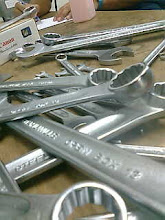| OEC | Osborn Engineering Company. Founded by Frederick Osborn who began building bicycles, then turned to motorcycles in 1901. OEC made motorcycles under contract with Blackburne until 1914. The company gained status when his son John took over around 1920 and started making their own first bikes. Took over the manufacture of Blackburne engines in 1921 as OEC-Blackburne. But used V-twin JAP engines in some of their own machines. Introduced a patented duplex steering system in 1927 and numerous innovations during its time. Company ran into financial trouble in 1930, and production halted, but restarted with fresh capital shortly after. Best known for its strange 1936 Atlanta Duo roadsters using a heavy but very stable duplex steering system designed by Fred Wood. Also offered a 998cc sidecar outfit with a steering wheel. In 1926 Claude Temple rode an OEC-Temple to the world speed record of 121.3 mph, and in 1930 Joe Wright rode a JAP-engined OEC at 150.736 mph. Also made a Whitwood Monocar, a two-wheel car with outrigger wheels and engines from 250 to 1000cc from 1934 to 36. Production ended in WW2 when the factory was bombed, but returned after the war with rear-sprung lightweights. The company's fortunes dimmed and production ceased in 1954. |
| Ogston | Made bikes 1911-13 (1914-16?), name adopted by Wilkinson-TMC. |
| OK, OK-Supreme | Founded as bicycle manufacturer Ernie Humphries and Charles Dawes in 1882, they dabbled with powered bicycles as early as 1899 and again in 1906. OK started manufacturing Precision-powered two-stroke motorcycles in Birmingham in 1911. OK-Precision won third place in the 1913 Lightweight TT. After WW1 they made several models using their own and Blackburne engines. Several OK machines were ridden to TT wins in this decade. Dawes broke away to form Dawes Cycles in 1926. Changed to OK-Supreme Motors in 1927. HRD designer Alec Bennett and E. J. Massey joined them in 1928. Humphries purchased the stock and tools of HRD in 1928, later selling the trademark to Phil Vincent. Made several models, including a 250cc Flying Cloud and the 1930 250cc Lighthouse (later 350cc, engines by Williams and James, later JAP) - named for a glass inspection plate in the camshaft tower and their finest model. It was also their final model, continued until 1939. After WW2 they produced a few 346cc grass-track bikes with JAP engines before closing in 1946. |
| Olivos | 1920-21. Used a 496cc Blackburne engine in an Olivos sprung-frame. |
| Olympic | Made two-stroke motorcycles with MMC engines 1903-19, then Verus and Orbit engines until 1923. Also sold the inexpensive New Courier line. |
| OMC | 1930-31. Lightweights, built by SOS. |
| Omega | 1909, used 1.5 hp horizontally-mounted engine. Another company of that name 1919-27 (1913-27? or 1913-1916?). |
| Onaway | 1904-08. Used a Kelecom 5 hp engine in a low-slung frame. |
| Orbit | 1913-24. Used own 260cc two-stroke and bought larger four-stroke engines for own frame. |
| Ormonde | 1900-05. Used small Kelecom and Antoine engines in own frame. Bought by Taylor-Gue in 1905 to become Veloce. |
| Ortona | 1904-06. Made one 3.5 hp model. |
| Osborne | 1910-11. Had four-speed belt pulley that could be adjusted while in motion. |
| Oscar | Dennis Poore launched this Villiers-powered scooter, 1953-55. |
| Osmond | 1911-24 (1902-26?). Made small (102-110cc) two-stroke engines, and used a 485cc precision for a larger single after 1918. Taken over by James in 1911. |
| Overdale | 1921-22. Used a small 169cc Villiers engine. |
| Overseas | 1909-15 (1913-23?). Export only, made an 842cc V-twin. |
Saturday, 6 August 2011
British motorcycle manufacturers - O
Subscribe to:
Post Comments (Atom)






1 comments:
mak aih, manufacturer utk motor kat british banyak gila kot.. siap susun ikut huruf lagi tu.. hehe
iefwatsahaja.com
Post a Comment